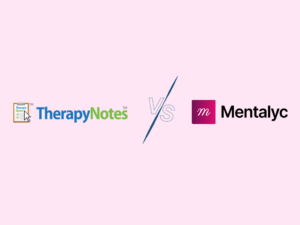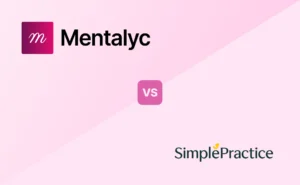Do you need help to keep up with creating practical treatment summaries for your clients? We know it’s tough to balance everything while providing exceptional care. But what if we told you you can learn to write stunning summaries quickly? Yes, you heard it right! Our ultimate guide is here to take you on a journey of becoming a treatment summary rock star. You’ll learn the purpose of a clear summary, its critical sections, and valuable tips to make each part shine.
And that’s not all – we’ll introduce you to Mentalyc, a tool that can save you precious weekly hours. By the end of this guide, you can summarize like a pro and gain insights into your clients’ journeys toward wellness. So, what are you waiting for? Dive into the world of compelling treatment summaries and become a master in no time!
What Is a Psychotherapy Treatment Summary and Why Are They Important for Mental Health Professionals?
As a mental health professional, you handle numerous clients, and treatment summaries can be beneficial in providing an overview of your client’s progress and care. A treatment summary is a concise report that ensures that you and your clients are on the same page about the treatment goals, interventions used, responses to treatment, and next steps. These summaries are also invaluable for documenting the quality and effectiveness of treatment, assessing outcomes to determine if treatment goals are being met, modifying or changing the treatment plan as needed, and protecting yourself legally by providing a clear treatment record.
Reviewing the initial treatment plan and comparing summaries from session to session, you can look for patterns, behaviors, or improvements that indicate progress. Assessing outcomes can help you see if the client’s presenting problems or symptoms have decreased in frequency or severity and identify other positive changes in thoughts, feelings, or behaviors. If progress seems slow or stalled, a different approach may be required, and treatment summaries can be used as evidence of the care and services provided should any issues arise.
Treatment summaries also help you track your client’s progress and identify patterns that may influence their care. You can quickly identify behaviors or symptoms that are improving or worsening and make necessary adjustments. Additionally, your clients can benefit from receiving a written treatment record. Summaries allow them to ask questions, provide feedback, and feel more engaged in their treatment plan.
With Mentalyc, you don’t have to write these summaries from scratch. The platform automatically pulls key points from your session and creates clear, easy-to-read overviews that you can also share with your client. This saves you time and helps both you and your clients stay on the same page.
Treatment Summary Template and Examples for Mental Health Practitioners
When creating a treatment summary, a template can help capture and document all relevant details of a client’s treatment. We recommend a template covering all essential sections to simplify the process. Feel free to modify the following sections and add items specific to your client and therapeutic approach. The more customized and comprehensive your summaries are, the better equipped you’ll be to provide consistent, high-quality care.
Here’s a template to help you get started:
Client Information
- Name, age, gender, relationship status
- Primary diagnosis and date of initial assessment
Presenting Problem
- Reason for seeking treatment
- Symptoms and behaviors observed
- Describe the client’s presenting problem or diagnosis in 1-2 sentences
- Include symptoms and severity to provide context for the treatment
For example:
Client presented with symptoms of moderate depression, including low mood, difficulty sleeping, poor appetite, and low energy.
Interventions and Treatment Goals
- Type of therapy (e.g., CBT, DBT)
- Frequency and duration of sessions
- Strategies, techniques, and interventions used
For example:
- Cognitive behavioral therapy focuses on negative thought patterns and increasing pleasant activities
- Mindfulness and relaxation techniques for stress and sleep management
List 2-3 specific, measurable goals you established with the client to work towards during treatment. For instance:
- Reduce symptoms of depression by 50% in three months
- Develop coping strategies to improve mood and sleep
Progress and Outcomes
Describe the client’s progress towards goals and any outcomes or changes in symptoms or functioning.
- Changes in symptoms, behaviors, coping skills
- Goal achievement and barriers
- Additional services or referrals provided
Provide specific examples and measurements when possible. For example:
- Client reported improved mood and increased interest in hobbies. PHQ-9 scores decreased from 19 to 9, indicating remission of depression
- Client established a consistent bedtime routine and reported sleeping 6-7 hours per night with improved energy during the day
Recommendations
Make recommendations for continuing progress, such as referrals, lifestyle changes, coping strategies to practice, or frequency of future sessions. For example:
- Continue practicing CBT and mindfulness techniques to maintain improvements.
- Follow up in 4-6 weeks to assess symptoms and progress.
- Continue the current treatment plan or modify it as needed
- Referral to psychiatrist or other practitioner
- Follow-up appointment schedule
We recommend exploring tools that automate note-taking, generate treatment plans, and offer customizable templates to streamline documentation and enhance client care.
Putting it All Together
Here are two examples that demonstrate how to use this template:
Client A presented with symptoms of depression and anxiety after a traumatic experience. Treatment goals focused on developing coping strategies and processing trauma. Over 12 sessions, the client showed significant improvement in mood and decreased panic attacks. Additional art therapy helped uncover repressed emotions. Recommended the client continues biweekly sessions to reinforce progress.
Client B sought counseling for anger issues and communication problems in his marriage—goals targeted developing healthy expression of feelings and conflict resolution skills. After eight sessions, the client demonstrated an improved ability to stay calm and compromise with his spouse. However, more progress is needed. Joint sessions and practice at home are recommended to strengthen new skills before reducing the frequency of appointments.
Best Practices for Writing Effective Psychotherapy Treatment Summaries
When writing a treatment summary, it is crucial to be concise and thorough. Your focus should be on the most integral points from your sessions that provide context for the client’s progress and the effectiveness of your interventions. Using these best practices will result in treatment summaries highlighting the meaningful work you and your clients have accomplished together.
Maintain a hopeful and encouraging tone
A positive, supportive tone will instill confidence in the treatment. While objectively discussing challenges, emphasize the client’s strengths, progress, and potential for continued growth.
Be selective
Choose important client journey details. Highlight pivotal moments, meaningful insights, obstacles overcome, and goals achieved. Avoid tangents.
Use specific examples
Refer to particular situations discussed in sessions that demonstrate changes in thinking or behavior.
For instance, “The client reported that they have been using the coping strategies we explored together to manage their anxiety in social situations. They mentioned that taking deep breaths and challenging their negative thoughts helped them to initiate a conversation with a stranger at a party last week. The client felt this would have been very difficult for them a month ago.”
Note measurable outcomes
Point to quantifiable improvements whenever possible, e.g., decreased symptoms of depression according to the PHQ-9, improved relationships as evidenced by the client’s self-report, and increased confidence as demonstrated through the client’s participation and demeanor in sessions.
Discuss next steps
Briefly outline your recommendations for continued progress and areas of focus for future sessions.
For example, “Will continue to practice mindfulness techniques to build awareness and tolerance of anxiety. Exploring a possible increase in work hours in a gradual, structured way.”
How Mentalyc Can Help Create Accurate Treatment Summaries
As a mental health provider, we know that you strive to offer personalized and compassionate care to each client. However, we also understand that documenting all the critical details and changes in a structured format can be overwhelming and time-consuming. That’s where we come in to provide our support. At Mentalyc, we have designed a digital platform that streamlines the process of generating summaries while maintaining high standards of consistency and objectivity. Our platform helps you demonstrate the impact and outcomes of your treatment, making your job easier and more fulfilling. By simplifying the process of creating summaries, you can have more time to devote to your clients and provide them with the care they need. We invite you to try Mentalyc today with our free trial offer. We aim to help you take your practice to the next level, and we are here to assist you every step of the way.
FAQ – Common Questions About Psychotherapy Treatment Summaries
Do you have some questions about treatment summaries? No worries, we’ve got you covered. Here are some of the most frequently asked questions about these important client records:
What exactly is a treatment summary for Psychotherapy?
A treatment summary documents a client’s progress and health over a period of time, allowing you to see the overall effectiveness of treatment. It details the client’s condition, symptoms, diagnoses, interventions, outcomes, and recommendations for future treatment.
How often should I write treatment summaries?
It’s best practice to complete a weekly, monthly, or more extended treatment summary at the end of each treatment period. Summaries should be written frequently to capture significant events, changes, or milestones in the client’s treatment. More frequent summaries, such as monthly, provide the most comprehensive record of the client’s progress.
What should be included in a treatment summary?
A good treatment summary should include:
- Client information (name, age, diagnosis, etc.)
- Summary of symptoms and conditions at the start of treatment
- Interventions, therapies, and medications used (if any)
- Client’s response to treatment and any outcomes or changes
- Recommendations for future treatment
- Any additional notes or observations
As a therapist, you understand the importance of providing top-notch care to your clients. But, it’s equally important to have excellent documentation skills, especially when writing treatment summaries. These summaries are instrumental in tracking your client’s progress and ensuring their treatment stays on track.
Creating an outstanding treatment summary requires telling an engaging story showcasing your client’s recovery journey. To achieve this, it’s important to deeply understand your client’s needs, goals, and progress. You can also use accurate data, such as progress notes and assessment scores, to support your observations and conclusions. Additionally, it’s essential to acknowledge any difficulties or setbacks your client may have faced and how they overcame them. By mastering these insider tips and best practices, you will be able to write insightful treatment summaries that demonstrate your work’s impact.
You understand that your clients need support and understanding as they navigate their recovery journey. By incorporating empathy and compassion into your treatment summaries, you can provide better client care and showcase your expertise and professionalism as a therapist.
Resources:
- Davis, S. (2021, July 5).The importance of a treatment plan with your mental health provider. CPTSDfoundationorg. https://cptsdfoundation.org/2021/07/05/the-importance-of-a-treatment-plan-with-your-mental-health-provider/
- Shamal, Dr. N. (2018, June 18).The “Why” & “How” of Tracking Treatment Progress. Time2Track Blog. https://blog.time2track.com/the-why-how-of-tracking-treatment-progress/
- Tsai, K. H., Moskowitz, A. L., Lynch, R. E., Daleiden, E., Mueller, C., Krull, J. L., & Chorpita, B. F. (2016). Do treatment plans matter? Moving from recommendations to action. Journal of Clinical Child & Adolescent Psychology, 48(sup1). https://doi.org/10.1080/15374416.2016.1204922
- Walton, Ph. D, R. (2012, August 1).Measuring therapy progress, effectiveness, and outcomes. Measuring Therapy Progress, Effectiveness and Outcomes | Colonial Behavioral Health. https://www.colonialbh.org/about-us/news-and-events/measuring-therapy-progress-effectiveness-and-outcomes.aspx
Disclaimer
All examples of mental health documentation are fictional and for informational purposes only.
Why other mental health professionals love Mentalyc

“Having Mentalyc take away some of the work from me has allowed me to be more present when I’m in session with clients … it took a lot of pressure off.”
LPC

“It’s so quick and easy to do notes now … I used to stay late two hours to finish my notes. Now it’s a breeze.”
Licensed Professional Counselor

“By the end of the day, usually by the end of the session, I have my documentation done. I have a thorough, comprehensive note … It’s just saving me hours every week.”
CDCII

“A lot of my clients love the functionality where I can send them a summary of what we addressed during the session, and they find it very helpful and enlightening.”
Therapist







